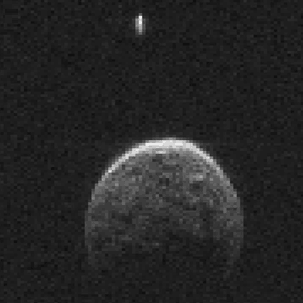Spectrally anomalous quasar?
-
I am by no means a quasar expert, but this seems odd:
210.5381 +54.2740The purple-ish object shows all signs of a quasar-like object, and yet is completely invisible in any infrared band- even far WISE bands. It's definitely an ultraviolet emitter, but I wonder why it's so dim in red bands.
Posted
-
 by
Budgieye
moderator
by
Budgieye
moderator
Not much info, it might be a binary star blue+red
4.8 spectroscopic binary stars https://talk.galaxyzoo.org/#/boards/BGZ0000001/discussions/DGZ0000wrb?page=4
http://simbad.u-strasbg.fr/simbad/sim-id?Ident=SDSS+J140209.12%2B541626.2&QueryType=ned
Posted
-
 by
planetaryscience
in response to Budgieye's comment.
by
planetaryscience
in response to Budgieye's comment.
Oh, I never thought about that! That looks like the best explanation here. Thanks, Budgieye.
Posted
-
Some thoughts; it hasn't moved in ~60 years so that would have been a good indicator of a star. To me it is visible in 2MASS J+K band and DS2 IR (+Spitzer) so not entirely invisible in IR. As far as not visible in WISE goes; if it is a Quasar it would be behind the outskirts of NGC 5457 so I can imagine that would grealy interfere with the IR wavelenghts of WISE. Also a bright object nearby which can 'outshine' this object.
Don't know if it is a UV emitter (source?), colour could be just a blend as can happen with binaries mimicking 'UV colour'.
DECaLS SDSS NGC 5457 area, object centered on image
But there are also quite some VizieR catalogues which have imaged / classified this object, including the CFHTLS and Spitzer. AFAIK all indicate a star. Couldn't find a binary star system in there, and checked the CFHTLS images in Aladin but couldn't distinguish two objects / binary pair, just one point source. Some other cataloge results taken from VizieR;
- SDSS says star ( The SDSS Photometric Catalog, Release 7 (Adelman-McCarthy+, 2009))
- Spitzer says star ( Spitzer photometry of ∼1million stars in M31 & 15 gal. (Khan, 2017)))
- FT Decision Tree says star ( Classifiers for star/galaxy separation (Vasconcellos+, 2011))
So apart from having a spectrum this is as close as certainty is possible that it is a star. But can't find any indication it is a binary system apart form the colour in SDSS.
Posted
-
 by
planetaryscience
in response to Ghost_Sheep_SWR's comment.
by
planetaryscience
in response to Ghost_Sheep_SWR's comment.
I initially suspected that the pinwheel galaxy would overload any far-infrared emission as well, but the brighter star this thing peeks out behind remains quite bright in WISE, while this one is all but invisible in the same bands the other star is bright in. It would have to be anomalously low-emission in far infrared for a quasar so bright in the visible bands.
It seems like a probable UV emitter, because GALEX images show an apparent bi-color source, with a whitish source where the bright star is, and a blueish one where the purple-ish object is. Looking around the sky, blue emission seems to be a signature of hot white dwarfs (like 13 26 13.646 +34 21 13.52)
Posted
-
 by
Ghost_Sheep_SWR
in response to planetaryscience's comment.
by
Ghost_Sheep_SWR
in response to planetaryscience's comment.
Ah, but I wasn't thinking detector-wise. If the object is/was a QSO it would be behind the pinwheel galaxy while the foreground star remains in front of it, so was wondering if that could cause a physical interference with the object WISE emissions? (Absorption?).
Ah didn't check GALEX, usually I trust NED UV references but this one is not in NED. Anyways it is visible in many IR surveys besides WISE, so coupled with optical mags might be possible to infer spectral type ( I'm not going to try that).
Posted
-
 by
c_cld
by
c_cld
GALEX J140209.1+541625 ultraviolet bright star SDSS-u, Galex NUV, Galex FUV
in Field NGC5457

Posted